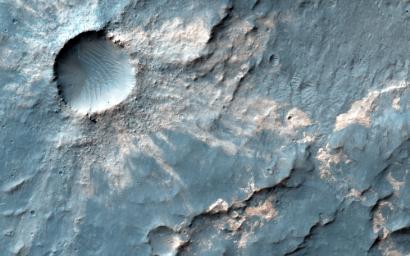
|
Craters within Craters
- Click the image above for a larger view
- Full-Res JPEG (2880 x 1800) (679.5 kB)
- Full-Res TIFF (2880 x 1800) (15.6 MB)
Caption:

Map Projected Browse Image
Click on the image for larger version
Sandwiched between a crater nearly 4 kilometer across and a much larger and older crater over 15-kilometers in diameter is this small impact crater with light-toned material exposed in its ejecta.
Because the material is still brighter than the surrounding surface , darker dust settling out of the atmosphere has not had time to cover it up, so the crater is fairly recent. Of course, "recent" could mean on the order of thousands of years or older. This small crater is also fairly shallow and smooth in its interior.
This light toned rock deposit is also visible along neighboring scarps and even in the rock strata exposed along the rim of the larger 15-kilometer crater, indicating that the formation of this rocky strata predates all of these craters. The brightness and color of these deposits are the result of different minerals within the rock relative to the nearby darker rocks and soils, and perhaps indicate extensive chemical interaction between water and the native rocks.
Background Info:
HiRISE is one of six instruments on NASA's Mars Reconnaissance Orbiter. The University of Arizona, Tucson, operates the orbiter's HiRISE camera, which was built by Ball Aerospace & Technologies Corp., Boulder, Colo. NASA's Jet Propulsion Laboratory, a division of the California Institute of Technology in Pasadena, manages the Mars Reconnaissance Orbiter Project for the NASA Science Mission Directorate, Washington.
Cataloging Keywords:
| Name | Value | Additional Values |
|---|---|---|
| Target | Mars | |
| System | ||
| Target Type | Planet | |
| Mission | Mars Reconnaissance Orbiter (MRO) | |
| Instrument Host | Mars Reconnaissance Orbiter | |
| Host Type | Orbiter | |
| Instrument | High Resolution Imaging Science Experiment (HiRISE) | |
| Detector | ||
| Extra Keywords | Atmosphere, Color, Crater, Dust, Impact, Map, Water | |
| Acquisition Date | ||
| Release Date | 2014-03-12 | |
| Date in Caption | ||
| Image Credit | NASA/JPL-Caltech/Univ. of Arizona | |
| Source | photojournal.jpl.nasa.gov/catalog/PIA17904 | |
| Identifier | PIA17904 | |
